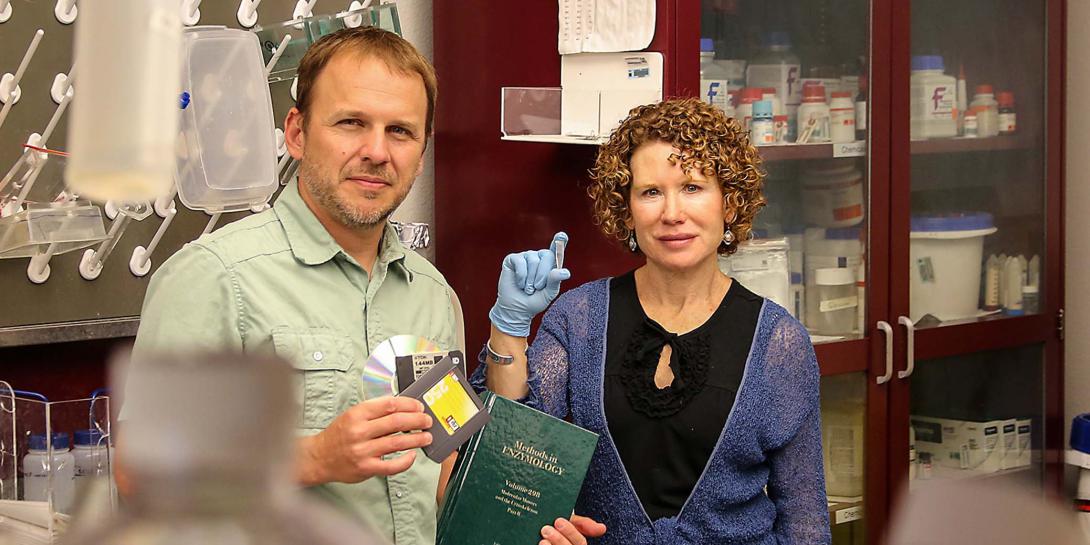Behind the Science: The Science That Binds
Behind the Science is an occasional series of blogs focusing on the people advancing science and technology.
George and Marlene Bachand, a married couple working at Sandia National Laboratories, have partnered on more science projects than they can recall.
He is a bioengineer, and she is a biologist. They’ve studied the toxicology of nanotechnology, exploring the effects of engineered nanotech on biological cells. One of their early projects at Sandia was researching “smart dust” sensors for the Defense Advanced Research Projects Agency. George describes the technology as “these really minute sensors you could disperse into the environment, and you wouldn’t have to do any hands-on diagnostics.” Such a mini sensor “would just do everything on its own and then provide a digital readout,” he says. He credits his wife with pioneering much of that research.
Two years ago, they made headlines as part of a team that created linkages of polymer nanotubes that resemble the structure of a nerve, with many out-thrust filaments poised to gather or send electrical impulses. The foundational science may one day allow nerves to be extended, providing a gentler interface between the human body and prosthetics.
George also contributed to a team that developed a credit card-size anthrax detector known as BaDx—short for Bacillus anthracis Diagnostic. The project earned the Federal Laboratory Consortium’s 2015 Award for Excellence in Technology Transfer, and the technology was licensed to Aquila, a woman-owned small business in New Mexico that specializes in designing and manufacturing technologies and services for nuclear security and international safeguards.
More recently, the couple helped develop a technique for securely storing vast amounts of text within synthetic DNA. The DNA-based encryption is far stronger than conventional technology and practically impossible to break. “The number of possibilities you would have to go through by brute force to get the correct code to do the decryption is basically infinite,” George says. He compares his method to 128-bit encryption, which Techopedia.com says is “considered to be logically unbreakable.”
The scientists cite the recent DNA encryption breakthrough as some of their most rewarding work so far with Sandia. “It was a fun project that you could see would have implications for future works,” Marlene says. “It seemed like it might be a benefit not just here at Sandia but … nationwide or even worldwide.”
George led the project. Marlene performed many of the early experiments that determined which avenues to take. She helped resolve how to break down large DNA strands into “sizable chunks” that could be synthesized, and she developed a process to “stitch the fragments together” during the early “trial and error process that probably took the longest time to do,” she explains.
They work together. They play together. They go home together. And some people see that as an oddity. “Everybody always asks us how we work with our spouse,” Marlene says. “I actually think that is our glue.”
The two met as students working in the same lab at Syracuse University. “We came together working in science and had that commonality ... of having the same kind of mind, and we also kind of have similar personalities,” Marlene explains. “When we work together, we both really get into the stuff that we’re doing, and that drives an appreciation for each other.”
Now, they work together so closely and seamlessly that George says it can be difficult to separate who is responsible for what work when it is time for performance evaluations. They seem surprised that others are surprised a couple can share both their personal and professional lives. “I guess we kind of like each other,” Marlene says.
Still, they point out that they are not exactly joined at the hip during lab hours. They each have their own projects and may not see each other more than once a day, so their work gives them plenty to talk about at home. “Because we’re always doing research, everything is new. This is all new to us, so we always have something fresh to talk about, and that keeps us cemented together a little bit,” she states.
Out of respect for their children, they have agreed not to discuss their jobs at the dinner table, although Marlene admits they are not always successful. Their son, Nick, inherited their love of science. The high school senior is researching colleges and considering a career in environmental science or wildlife biology. Their daughter, MayLi, is a sixth-grader. She was adopted from China and has a brilliant mind for languages, communication and acting, her parents boast.
When outside the lab, the couple likes to be outside. They enjoy hiking and biking, for example. Marlene says she is probably into every kind of fitness activity available, while George enjoys backpacking, camping and ice hockey.
The two have been married since 1997. George confesses that he did not offer a romantic proposal. “Being the pragmatic scientists that we are, it was more of an agreement than a proposal,” he says, and they both laugh at the memory. George asked what Marlene’s response would be if he were to propose—hypothetically, of course. “Yeah, and then it all just kind of evolved after that, and next thing we knew we were talking about whether we should set a date or not,” Marlene recalls, still laughing. “There was no romantic stuff in there. No ring, no special dinner, no nothing.”
George adds, “We were both broke grad students.”





Comments